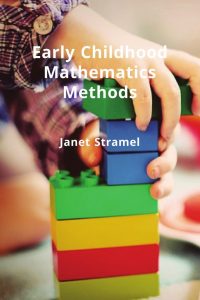Mathematics Methods for Early Childhood
Moesha Williamson

Stramel, J. (2021). Mathematics Methods for Early Childhood. Fort Hays State University. https://open.umn.edu/opentextbooks/textbooks/mathematics-methods-for-early-childhood
Reviewed by: Moesha Williamson, Lehman College
Introduction
The OER I choose to evaluate is Mathematics Methods for Early Childhood. One author, Janet Stramel, published this book from Fort Hays State University. The content of this book focuses explains how “Mathematics in early childhood helps children develop critical thinking and reasoning skills early on, and it’s the key to the foundation for success in their formal schooling years.” It is licensed under the Creative Commons Attribution License (CC-BY).
Evaluation
Content: This book focuses on the importance of mathematics at an early age. The content is at a level that anyone with a general reading level quickly understands. The textbook arranges the content by importance level from birth to grade 3. The book is based on evidence and factual data. The book has been updated twice this year alone, so some outdated references were changed.
Structure, Organization, & Technical: The book is available in PDF and EBook form free of charge. It is organized into twelve chapters with a Glossary which helps when searching for a specific topic. Each chapter is an addition to the previous chapter. Each chapter has content divided into sections making it easy to navigate the text. Although the book was easily navigable, an introduction or summary at the beginning of each chapter would be helpful to the reader.
Images & Interactive Features: The books incorporate images that are relevant to the topic being discussed. The author also provided highlighted terms with the hover-over effect of defining keywords. The writer also includes articles that support their claims to allow the reader access to research to verify the information and explore the research further without a hassle. The author discusses specific points throughout the book and provides outside resources such as an interactive clock, live worksheets, and secondary articles to encourage readers to gather more in-depth information. I am not sure if this was intentional but some of the word formats were not consistent. Throughout the book, a sentence or word may be capitalized and written in a different font from the rest of the text in that section.
Social Justice & Equity: The book focuses on a specific topic and it is not generalized. The idea is to shine a light on the positive effects teaching mathematics at an early age has on a child. Although the book does not focus on a specific cultural, ethnic, or racial background, it could have biased information. I say this because most of the research is based in Kansas, a predominantly white state. “Outsiders” might not be able to relate. Also, 99% of the images provided portray white children.
Accessibility : This textbook is accessible because the book is free of charge,and the author provides a printable PDF form, so access to constant technology is unnecessary. However, it would be hard to benefit from the hyperlinks and the secondary sources included throughout this book in a printed format.
Supplemental Materials: The writer summarizes the main ideas discussed at the end of each chapter. There are also outside resources provided within the readings to help with readers’ comprehension and provide supports to readers to use in their classrooms. At the end of the book, the author also provides all the references used in the text, organized by chapter. There’s also an appendix which allows readers to add any information that they may think is relevant to the work being discussed in the book.
Overall Review
Overall, this book can be beneficial to parents who want to help with the cognitive development of their children and teachers who wish to learn new ways to approach mathematics with young children. Some tweaks such as proper review to make sure the font is the same and adding more relatable pictures to a more diverse population can be made. I would not recommend this text be used in diverse settings only because the research was conducted on one group of individuals and might not benefit other groups of children.
